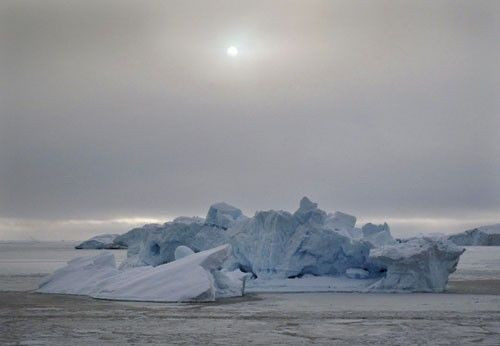NASA Study Shows Ice Sheets Melting Faster

Data from NASA satellites shows that both the Greenland and Antarctic ice sheets are melting faster, and have become a bigger contributor to rising sea levels than before.
The most recent study is being published in Geophysical Research Letters. It combines data from several satellites to measure the rates of mass loss (as opposed to extent) over a two decade period. The results showed the ice is melting even faster than the computer models had predicted.
Other studies have also pointed to worrying signs that the ice sheets are melting faster than first thought. In January, a team at the Cryospheric Processes laboratory at the City College of New York found that the melting index for the Greenland ice sheets had broken the previous record, set in 2007. That work isn't directly connected to the study of mass loss of the ice sheets.
The recent research found that in 2006, the ice sheets from both regions lost a combined 475 billion metric tons a year, or about 518 cubic kilometers of ice. NASA says it is enough to raise sea levels by 1.3 millimeters in a year.
The loss rate was also found to be increasing. In each year of the study, Greenland and Antarctica lost an average of 36.3 billion metric tons more than the year before. Data from that same year looking at the ice caps (such as the glaciers in Iceland or Svalbard) and mountain glaciers showed a loss of 402 billion metric tons per year. While the loss rate is accelerating there also, it is only one-third as fast as the ice sheets. (The polar ice cap, which rests on the ocean, does not contribute to sea level rise).
In a statement lead author Eric Rignot, of NASA's Jet Propulsion Laboratory, Pasadena, Calif., and the University of California, Irvine, noted that ice sheets have more ice than mountain glaciers, so it isn't surprising that they would contribute more to sea level rise. What is surprising is this increased contribution by the ice sheets is already happening. If present trends continue, sea level is likely to be significantly higher than levels projected by the United Nations Intergovernmental Panel on Climate Change in 2007, he said.
Rignot's team combined nearly two decades of monthly satellite measurements, covering the years 1992 to 2009, with regional atmospheric climate model data to examine changes in ice sheet mass and trends in acceleration of ice loss.
The study compared different measurement techniques. One was radar data from European, Canadian and Japanese satellites and radio echo soundings. That was used to measure the ice leaving the ice sheets. Climate model data was used to figure out how much ice was being added.
Another technique used eight years of data from the Gravity Recovery and Climate Experiment (Grace) satellites, operated by NASA and the German Aerospace Center. They track changes in Earth's gravity field resulting from alterations in Earth's mass distribution, including ice movement.
The team found that the different ways of measuring ice loss were in agreement over the eight-year period in which the data overlaps. That told them that the data was valid and helped establish a record of ice mass changes since 1992.
They found that each year, the Greenland ice sheet lost mass faster than it did the year before, by an average of 21.9 billion tons a year over an 18-year period. In Antarctica, the year-over-year speedup in ice mass lost averaged 14.5 billion tons.
These are two totally independent techniques, so it is a major achievement that the results agree so well. It demonstrates the tremendous progress that's being made in estimating how much ice the ice sheets are gaining and losing, and in analyzing Grace's time-variable gravity data, said co-author Isabella Velicogna, also with JPL and UC Irvine, in a statement.
The authors conclude that if the ice sheets keep melting at the same rate for the next 40 years, sea level will rise by about by 15 centimeters (5.9 inches) by 2050. When this is added to the predicted sea level contribution of 8 centimeters (3.1 inches) from ice caps and 9 centimeters (3.5 inches) from ocean thermal expansion, total sea level rise could reach 32 centimeters (12.6 inches).
Such rises are not large, but Rinot notes that even a small increase can add up. Remember this is only out to about 2100, he said. The sea level rise doesn't stop then.,, For some of these Pacific island nations a meter is the difference between being there and not.
To contact the reporter responsible for this story call (646) 461 6917 or email j.emspak@ibtimes.com.
© Copyright IBTimes 2024. All rights reserved.





















